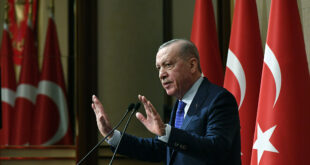Even as the so-called Islamic State (IS) embarks on a new phase of global expansion, as evidenced by the recent Easter attacks in Sri Lanka, its jihadist rival Al Qaeda is enjoying a resurgence in the Syrian conflict theatre.
Almost twenty years on from the September 11 attacks, Al Qaeda’s Syrian affiliates have seized control of Idlib, a province located in north-east Syria, in a series of dramatic advances in recent months and established the prototype of a caliphate over an estimated three million people.
Since the beginning of the year, Al Qaeda-linked Hayat Tahrir al-Sham (HTS), the dominant jihadist alliance in the region, has extended administrative control through its self-proclaimed “Salvation Government” to more than two dozen towns and villages in northern Syria after forcing out rival rebel groups. These advances are the latest blow to a September 2018 cease-fire brokered by Russia and Turkey for Idlib, the last major stronghold of a coterie of rebel and jihadist factions trying to overthrow Syrian leader Bashar Assad for the past seven years.
Consolidation of Power
Like IS, which previously captured large swathes of Iraq and Syria and declared its intention to spread jihad around the world, HTS seeks to topple the Syrian regime and establish an Islamic state. Whereas IS expanded rapidly and sought to grab the international headlines for its resort to brutal tactics, HTS has played a long game. By adopting a “glocal strategy”, wherein global ambitions are set aside to gain popular support and territory locally, Al Qaeda has gained traction in Syria.
With up to 20,000 fighters, HTS is now the most powerful jihadist coalition in Syria and has perhaps the largest concentration of armed jihadists ever assembled in one place. It has also been described by a former US envoy to Syria as “the largest Al Qaeda safe haven since 9/11”.
HTS’ army unites multiple local and foreign Salafi-jihadist groups, the core constituents of which evolved out of Al Qaeda’s former Syrian branch, Al Nusra Front. There are thousands of fighters from Albania, China, Central Asia, Iran, the Maldives and Russia also in its ranks. HTS and most of its satellite affiliates are designated as Al Qaeda-linked terrorist organisations by the United States, Russia, Turkey as well as the United Nations.
In anticipation of a possible government offensive into Idlib, the group has developed an estimated 10 highly-trained ‘commando’ units within jihadist factions fighting under its hierarchy. For this purpose, it has hired Malhama Tactical, a private jihadist mercenary group led by an ex-Russian special air forces soldier, to provide special tactical training to its elite units, known as Asaib al-Mawt (‘Death League’) and Asaib al-Hamra (‘Red Bandanas’).
This training has also been extended to foreign fighter divisions from China, Kyrgyzstan, and the Maldives among others. Some of these fighters were trained to become inghimasi – suicide shock troops who are deployed to launch surprise raids into fortified enemy positions.
HTS’ Collapse Looming?
In recent months, HTS has come under severe military pressure from the Syrian regime and its ally Russia. The September peace accord inked by Russia and Turkey, a backer of the Syrian opposition, has delayed a government offensive to recapture the province. Turkey has deployed military forces on the ground in Idlib to deter an all-out government offensive.
Turkey had hoped the deal would buy time for an agreement to be struck between Damascus and the remaining rebel holdouts and avert a fresh refugee crisis into its borders and further afield into Europe. However, HTS’ recent gains in Idlib indicate that Turkey’s efforts aimed at the voluntary disarmament and disbanding of the jihadists have proven futile so far.
Most observers argue that a government offensive may be imminent in Idlib. Damascus is unlikely to tolerate, for much longer, the existence of armed jihadist groups in such a strategically significant province. For the Syrian regime, Idlib represents the last stop in its protracted seven-year-old civil war, which it hopes to bring to a swift end and ensure the territorial integrity of Syria.
The presence of significant numbers of Al Qaeda-linked Central Asian and Russian militants in Syria is also a security concern for Russia. As retaliation for Russia’s military involvement in Syria, HTS and its Central Asian ally of Kateeba Tawheed wal-Jihad (KTJ) carried out a metro bomb attack in Saint Petersburg in April 2017.
The region has come under increasing bombardment since the beginning of the year, with the UN warning that an escalation in violence could threaten the delivery of aid to some 2.7 million people in need. According to estimates, more than 86,500 people fled their homes in February and March as a result of the surge in violence. HTS has also resorted to increasingly repressive tactics to maintain control of its territory. Since the beginning of 2019, the group carried out more than 460 attacks against the regime forces, which have resulted in more than 30 deaths in Idlib.
Internal Divisions
Despite attempts to present a united front, HTS is afflicted by internal disputes and defections. Its leadership is divided into two camps. The first, comprising hard-line foreign fighters, reject any negotiations with Turkey and seek to continue fighting against the Syrian regime.
The other camp, comprising mainly local fighters, including the group’s leader Abu Mohammed al-Julani, appears willing to endorse Turkey’s plans in order to avoid a full-fledged offensive.
Amidst such internal fissures, Ankara has called for a targeted campaign against the hard-line factions of the group, as opposed to a full-fledged military operation. Through a calibrated approach, Turkey seemingly appears intent on gradually weakening and eventually defeating the jihadists.
Possible Implications
The overwhelming political and military pressure exerted by Turkey, Syria and Russia is likely to precipitate the collapse of HTS in Idlib. If this happens, it will most likely herald an end to the group’s insurgent identity in Syria.
Despite this, instability in the Iraq-Syria theatre and elsewhere continues to provide conditions for militants to exploit. If a dissolution of HTS’ jihadist alliance was to materialise, some hard-line factions could regroup under Al Qaeda’s global banner and start launching attacks beyond the Syrian conflict zone.
It could also trigger a broader movement of foreign terrorist fighters (FTFs) across Syria and the surrounding regions. Russian security officials indicate that battle-hardened fighters from China, Russia and the Central Asian states may return home or venture into other conflict theatres, particularly Afghanistan.
For its part, IS remains potent as an active insurgency in Iraq and Syria, while maintaining branches across the globe. In Afghanistan, both Al Qaeda and IS command at least five Central Asian and Uyghur jihadist groups and also maintain ties with the Maldivian and Russian fighters. Taken together, countries will need to respond to national and transnational security threats posed by these factors as part of a broader counter-terrorism strategy.
 Eurasia Press & News
Eurasia Press & News


